Warranty Cost Reductions:
While the warranty costs of most companies are falling, the causes aren't always the same. The big companies are making the process more efficient. But for many of the smaller companies, the biggest cost reductions seem to arise after mergers and divestitures.
Warranty costs are falling for both the big companies and for the smaller manufacturers. But while we think the biggest are making better products that cost less to repair, we also suspect that some of the cost reductions have more to do with changes in the product mix.
Last week, when we compared the current warranty costs of the 100 largest manufacturers to their year-ago warranty costs, we found sales rising, claims falling, and the percentage of sales going towards warranty work falling even faster. This, we said, was an example of the practitioners of warranty management getting better at what they do.
That led to two more questions: First, how do current claims rates compare to periods longer than just a year ago, and second, does the same declining cost trend also hold for smaller warranty providers?
We're happy to report that the downward trend in warranty costs seems to hold no matter which time period we choose. And it seems to hold for not only the top 100 largest warranty providers, but also for smaller companies.
Increased Volatility
There does seem to be more volatility, however. When we widened the study, most of the biggest companies fell out of the top ten range, replaced by smaller companies whose claims rates were rising or falling much more precipitously.
In our widened sample, for instance, there were 15 companies whose claims rate had fallen by 50% or more in the past year. Last week, we found only two large companies whose claims rates had fallen by 50% or more during the same period.
And the effects of a merger or divestiture seem to be more pronounced with the smaller warranty providers. When someone as big as HP buys a company such as Palm Inc. the product mix changes imperceptibly, and so does the warranty cost. But when these smaller companies sell a division or merge with a competitor, the effect on warranty costs is quite noticeable.
So while we can state that warranty cost reductions are just as common with smaller companies as with larger companies, the reasons for the falling percentages may not be the same. For the smaller companies, almost every mammoth rate change seems to have an explanation that has little to do with them making more reliable products. For the larger companies, these special circumstances are far less common.
Widening the Sample Size
To widen the study, we selected the 205 largest warranty providers of 2010, each of which paid out $5 million or more in claims last year. And we took the metric for claims as a percentage of sales, calculated for June 2011, and compared it to the same metric for each company as of June 2008 (three years ago), June 2006 (five years ago), and June 2003 (eight years ago).
What follows is a summary of some of our findings. In Figure 1, we've listed the top ten claims rate reductions since June 2003. As you can see from the right-most column, all of these reductions were massive. For instance, medical equipment manufacturer Teleflex Inc. cut its claims rate from 0.4% of sales to only 0.01% -- a 97% reduction!
Figure 1
Top 100 U.S.-based Warranty Providers:
Eight-Year Claims Rate Reductions,
First Half 2011 vs. First Half 2003
(claims as a % of sales)
| Claims | Claims | Eight | |
| Rate | Rate | Year | |
| Company | Jun '03 | Jun '11 | Change |
| Teleflex Inc. | 0.4% | 0.01% | -97% |
| AutoZone Inc. | 1.7% | 0.1% | -96% |
| Hologic Inc. | 3.0% | 0.3% | -91% |
| JDS Uniphase Corp. | 2.7% | 0.3% | -87% |
| Raytheon Co. | 1.1% | 0.2% | -84% |
| Cypress Semiconductor | 1.0% | 0.2% | -84% |
| Varian Semiconductor | 3.1% | 0.7% | -78% |
| Waters Corp. | 2.8% | 0.6% | -78% |
| Rofin-Sinar Technologies | 3.9% | 0.9% | -78% |
| KLA-Tencor Corp. | 4.4% | 1.0% | -78% |
On this list, all ten companies cut their warranty claims rates below one percent. KLA-Tencor's June 2011 claims rate, at 0.96%, was rounded up to one percent.
Of the 205 largest warranty providers of 2010, we were able to calculate claims rates for 192 of them for the quarter ending in June 2011. The 13 others report their warranty costs only once a year, so we won't have any new data until March 2012 when their annual reports arrive.
Of those 192 companies, fully 73% have reduced their claims rates in the past year. Around 64% are down from three years ago. About 63% are down from five years ago. And 72% are down from eight years ago. So the trend did not begin recently.
Making Every List
In fact, two of the companies that cut their claims rates by the most since 2003 also topped the five-year, three-year, and one-year comparison lists. Cypress Semiconductor Corp. and Teleflex made each and every list. But there were an incredible 50 companies that reduced their warranty claims rate for each and every time period we sampled: three years, five years, and eight years.
As mentioned, Teleflex was one of them. As can be seen in Figure 2, the company's most recent claims rate is also its lowest ever. And its accrual rate is just as low. The company spent only $89,000 on warranty claims during the first half of 2011, against $745 million in sales. Back in 2003, it spent $9.5 million on nearly $2.3 billion in sales.
Figure 2
Teleflex Inc.
Warranty Claims & Accrual Rates, 2003-2011
(as a percentage of product revenue)
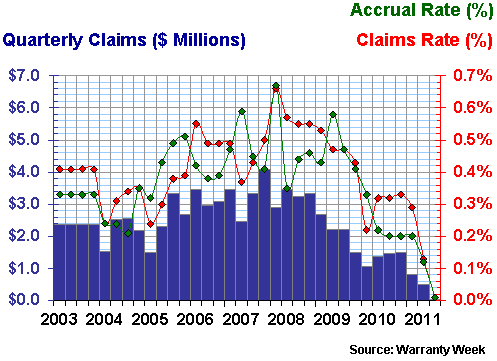
Why the precipitous drop? It probably has to do with the product line, and some key divestitures the company has made in recent years. Teleflex opened in 1943 as an airplane parts manufacturer. It later entered both the automotive and maritime businesses as a parts supplier. But then in the 1970s it began to focus on the medical equipment market, and in the past ten years it has sold off most of the non-medical product lines.
So what we're really seeing in Figure 2 is a company whose product line is both shrinking and changing at the same time. And while for an auto parts suppliers an 0.5% claims rate is typical, in the medical equipment market much lower rates are common.
Mergers & Acquisitions
Another company that saw its claims rate fall by massive proportions is Hologic Inc. In Figure 3 below, one can see how the company's claims rate has fallen from 3.0% in 2003 and 1.0% in 2006 to only 0.3% in June 2011. But again, it has more to do with changes in the product line. In this case, it was the 2007 merger with Cytyc Corp. that more than doubled product revenue without adding a proportional amount of warranty expense. So of course, rates dropped.
Figure 3
Hologic Inc.
Warranty Claims & Accrual Rates, 2003-2011
(as a percentage of product revenue)
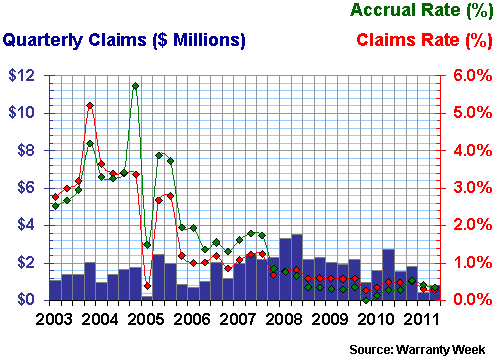
Before the merger, Hologic's claims rate was only occasionally below one percent. Since the merger, it's never been above one percent. The dollar amounts spent on claims have remained around $2 million per quarter, but now they're spread among lots more revenue than before.
There were a variety of reasons for the eight-year cost reductions. Some, such as Teleflex, are in the right place at the right time in 2011, having shed their warranty-intensive product lines. Others, such as JDS Uniphase Corp., were in the wrong place at the wrong time back in 2003. Back then, the telecom equipment component maker was experiencing rapidly rising warranty costs, which peaked at 3.5% of sales revenue in late 2003 and again in early 2004. Ever since, claims costs have remained below one percent. So whatever problem the company had, it's fixed now.
Five-Year Comparisons
Compared to five years ago, 63% of our top warranty providers have reduced their claims rates. And boy was it tough to make the top 10! Twenty companies cut their claims rates in half or better. A hundred companies reduced their claims rates by 10% or more. And top warranty providers such as Thermo Fisher Scientific Inc., EMC Corp., and Juniper Networks Inc., each of which cut its claims rate in half since 2006, couldn't get near the top ten list in this widened sample.
At the other extreme, 59 companies saw their claims rates rise by 10% or more since June 2006. And 13 saw their claims rates double or more in the past five years. But we won't dwell on those.
Figure 4 lists the top 10 claims rate reductions in the five years between June 2006 and June 2011. Six of those companies are also on the eight-year list in Figure 1, and five are also on the three-year list in Figure 7.
Once again, industries known for low average claims rates dominate the list: five are medical equipment makers, and three are semiconductor and printed circuit board manufacturers.
Figure 4
Top 100 U.S.-based Warranty Providers:
Five-Year Claims Rate Reductions,
First Half 2011 vs. First Half 2006
(claims as a % of sales)
| Claims | Claims | Five | |
| Rate | Rate | Year | |
| Company | Jun '06 | Jun '11 | Change |
| Teleflex Inc. | 0.5% | 0.01% | -98% |
| Accuray Inc. | 4.9% | 0.6% | -88% |
| Raytheon Co. | 0.8% | 0.2% | -78% |
| Hologic Inc. | 1.0% | 0.3% | -72% |
| Waters Corp. | 2.0% | 0.6% | -69% |
| Cypress Semiconductor | 0.5% | 0.2% | -69% |
| FLIR Systems Inc. | 1.5% | 0.6% | -63% |
| KLA-Tencor Corp. | 2.4% | 1.0% | -60% |
| Cymer Inc. | 4.0% | 1.7% | -58% |
| Medtronic Inc. | 0.4% | 0.2% | -58% |
Accuray, we should note, is the name of the company that acquired TomoTherapy Inc. earlier this year. So the 2006 warranty expenses were TomoTherapy's alone, while the 2011 expenses are for the combined company. And TomoTherapy didn't begin reporting its warranty expenses until 2005.
In addition, although TomoTherapy is a medical equipment company, it specializes in radiation therapy. And as we've noted in past newsletters, any equipment involving radiation or lasers is almost always going to attract above-average warranty costs. Combine that with Accuray's robotic radiosurgery equipment, and you have a much larger company with much lower warranty costs.
Internal Cost Reductions?
But let's look beyond the medical industry for some manufacturers who have cut their warranty costs internally, not through mergers or divestitures. FLIR Systems Inc., which is deeply involved in the infrared imaging, navigation and surveillance industry, has made a few small acquisitions over the past decade. But the cost-cutting that helped FLIR reduce its claims rate from 1.5% to 0.6% in the past five years came mostly from within.
Among the semiconductor and printed circuit board makers on the list, the sales growth and cost-cutting has also come mostly from within. However, Cypress Semiconductor is well-known for acquiring small companies and spinning off larger companies. And perhaps this is why the data in Figure 5 below seems so volatile.
Figure 5
Cypress Semiconductor Corp.
Warranty Claims & Accrual Rates, 2003-2011
(as a percentage of product revenue)
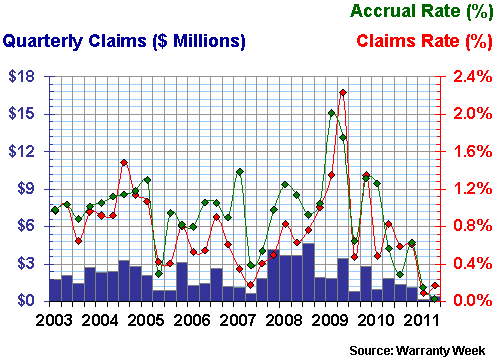
Cypress, like Teleflex, is currently enjoying its lowest warranty costs of the past eight years. But despite its many acquisitions, the urge to cut costs seems to come from within. It has moved much of its manufacturing to Asia. And it's quick to exit markets it feels are underperforming, and to enter markets that are growing. For instance, its Emerging Technology Division manufactures trackballs for smartphones and programmable chips for electric bicycles, among other products.
Chip Monitoring Equipment
KLA-Tencor, meanwhile, is not so much making the chips and circuits themselves as it is making the test equipment that monitors the manufacturing process and inspects the output. Back in mid-2003, this product line generated a good deal of warranty expense. But then those warranty expenses began to decline.
As can be seen in Figure 6, the company's claims cost declined for almost two years before bottoming out at 1.2%. Then claims rose for the next four years, with the claims rate peaking at 3.6% in late 2008. Since then, another downward trend has taken claims below one percent -- a new low for KLA-Tencor.
Figure 6
KLA-Tencor Corp.
Warranty Claims & Accrual Rates, 2003-2011
(as a percentage of product revenue)
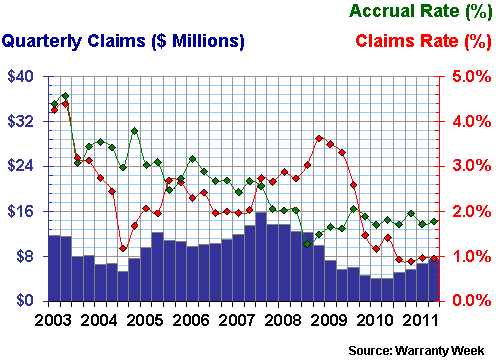
Cymer Inc., meanwhile, makes equipment that is used to manufacture advanced semiconductor products. More specifically, its equipment generates the ultraviolet light used to imprint silicon wafers with very small, very intricate circuit patterns. Back in 2003, this line of business generated warranty costs equal to 6.3% of sales. In 2004, that claims rate shot up above 10%. But it fell to 4.0% in 2006 and dipped under two percent last year. So although Cymer made only one top ten list, its claims costs have been falling more or less constantly since 2003.
Three-Year Comparisons
The three-year chart, seen below in Figure 7, has a lot of familiar names on it. Four companies, including Teleflex, Cypress, Hologic, and KLA-Tencor, are on all three lists. In addition, Varian Semiconductor Equipment Associates Inc. is also on the eight-year list, and Accuray is also on the five-year list. Incredibly, there are only 18 different company names among the 30 entries on all three lists.
In other words, there's some consistency to the group of companies that have managed to cut their warranty costs since 2003. It's not a totally different group each time. In fact, nine of the ten companies on the list in Figure 7 have also seen their claims rates decline since the middle of 2010. The sole exception is Teradyne, which had an 0.7% claims rate a year ago and an 0.9% claims rate in June 2011.
Figure 7
Top 100 U.S.-based Warranty Providers:
Three-Year Claims Rate Reductions,
First Half 2011 vs. First Half 2008
(claims as a % of sales)
| Claims | Claims | Three | |
| Rate | Rate | Year | |
| Company | Jun '08 | Jun '11 | Change |
| Teleflex Inc. | 0.5% | 0.01% | -98% |
| Accuray Inc. | 8.0% | 0.6% | -93% |
| Microsoft Corp. | 6.9% | 1.4% | -79% |
| Nautilus Inc. | 5.0% | 1.1% | -78% |
| Cypress Semiconductor | 0.6% | 0.2% | -73% |
| Novellus Systems Inc. | 9.3% | 2.7% | -71% |
| Varian Semiconductor | 2.3% | 0.7% | -71% |
| Hologic Inc. | 0.8% | 0.3% | -66% |
| KLA-Tencor Corp. | 2.8% | 1.0% | -65% |
| Teradyne Inc. | 2.4% | 0.9% | -62% |
Microsoft is one of the companies making only one appearance on a top ten list. This is because until the Xbox 360 debacle hit in 2007, Microsoft didn't really have much warranty expense. So the only list it was likely to make was the one comparing 2008 to 2011.
Its claims rate actually peaked in early 2008 at 11% of the game division's revenue. But in the second calendar quarter of 2008, it had declined to 6.9%. In the second calendar quarter of 2011, it was down to 1.4%.
Returning to Normal
Novellus is another company that's making only one appearance on these top ten charts. But its claims rate is actually down since both 2003 and 2005 -- just not by top ten magnitudes. In Figure 8, it's easy to see why. From 2003 to 2007, the company's claims rate remained within a range of four to seven percent. But then it spiked all the way up to 18.7% in 2008, before crashing back in 2009 and 2010.
Figure 8
Novellus Systems Inc.
Warranty Claims & Accrual Rates, 2003-2011
(as a percentage of product revenue)
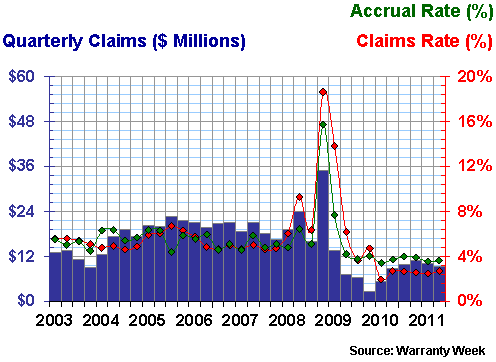
The claims rate, of course, is calculated by dividing product sales into claims cost. There are two drawbacks to this. First, when sales fall fast, as they typically do during a recession, the claims rate can jump even if the quarterly cost remains about the same. Second, claims arrive months if not years after a product is sold. So if sales are falling, this lag time exaggerates the jump in the claims rate.
In Figure 8, however, it's clear that the spike in the claims rate to 18.7% was also accompanied by a spike in the claims cost to $35 million per quarter. Yes, sales were down as well, but claims more than doubled from the previous quarter. So this was a problem in the product line, not in the sales totals.
Falling Sales, Rising Claims
In Figure 9, however, one can see how the quarterly claims totals and the claims rate don't always seem to relate. Sometimes the totals are high when the percentages are low, and the totals fall when the percentages spike. This means the volatility has more to do with sales fluctuations than with changes in the frequency or cost of product repairs.
Figure 9
Nautilus Inc.
Warranty Claims & Accrual Rates, 2003-2011
(as a percentage of product revenue)
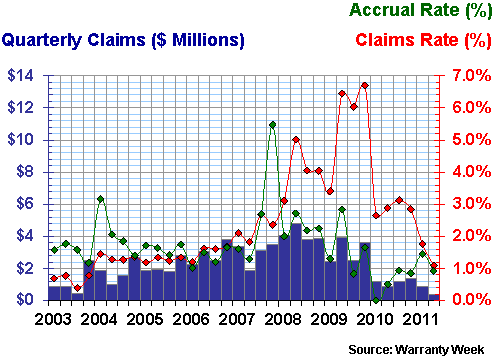
For instance, in the second quarter of 2008, Nautilus spent $4.8 million on claims while selling $95.6 million worth of exercise equipment. So its claims rate was five percent. But then towards the end of 2009, Nautilus sold its StairMaster product line, and in the resulting annual report, warranty costs fell a bit while sales fell a lot. The result was a claims rate above six percent for most of the year.
However, we're not making comparisons to two years ago. Compared to three years ago, Nautilus' claims rate is down 78%. Compared to five years ago, it's down 33%. But compared to eight years ago, it's up by 42%.
Top Decliners
By the way, among the 18 companies that made one or more lists, there were only ten instances where their claims rate had risen in 2011, compared to either 2003, 2006, or 2008. In contrast, there were 44 instances where their claims rates had fallen. And 30 of them were large enough to make it onto a top ten list. So this group is consistent, not only in terms of the direction, but also of the magnitude of their changes. They're mostly down, and they're down a lot.








